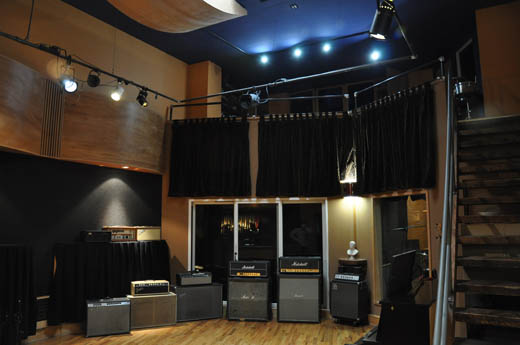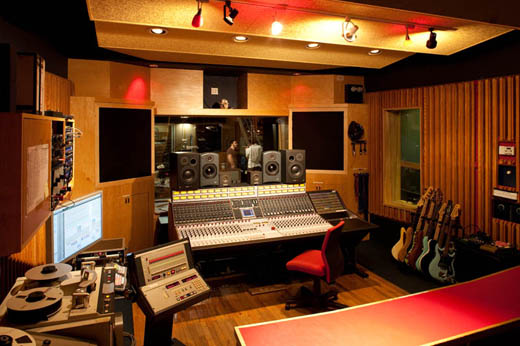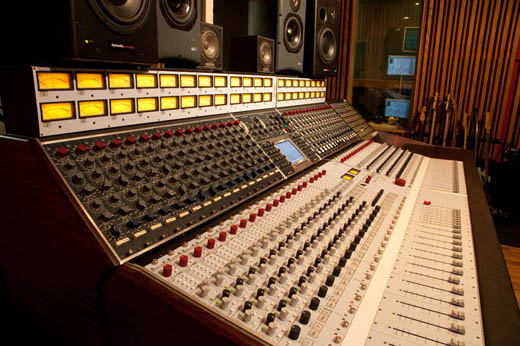LoHo Recording Studios – Blue Men, Living Legends, and Weekend Warriors
Loho Studios has lived multiple lives. Between 1983 and 2007 it evolved from a downtown rehearsal space to a world-class recording studio, hosting living legends like Willie Nelson, Patty Smith, Joan Jett, Yo La Tengo, Art Garfunkel and Joey Ramone.
Following this 25-year run it disappeared from the market completely—presumably moth-balled, or auctioned off in pieces like so many of the best NYC studios. But after couple years out of the public eye, LoHo returned to the commercial market in 2009 with a new staff and new owners.
Today, engineer Matt Werden spends his weekdays working out of LoHo’s loft-like, two-story live room with the its new owners, the Blue Man Group. For Werden, there’s no such thing as a “typical” session. A day with Blue Man could mean rehearsals and sound design for the group’s live shows, mix sessions for short films and TV spots, or the recording of any number of sci-fi PVC-based instruments.
Nights and weekends are a different story. Since 2009, the studio has begun to open its doors to commercial bookings after-hours. When we talked to Werden, he was fresh off a month full of 7-day work weeks that found him splitting his time between his Blue Man duties, and recording the Brooklyn psych-rock band New Beard.
“The studio occupies this nice middle segment,” says Werden. “It’s small enough and affordable enough that it’s accessible, but since it’s subsidized by Blue Man, we have all this great gear.”
“The big thing for me is that we have enough isolation booths and great gear to get keeper tracks from a whole band playing at the same time. Not everyone can afford to go up to Avatar for that kind of thing.”
In addition to serving artists directly, the room is available to freelance engineers looking for a new mixing or tracking space. Although regular business hours are essentially locked-out in advance, Werden feels the pricing and benefits outweigh the limitations.
He says he’s come to trust the monitoring in the control room, and thinks it’s especially easy for outsiders to adapt to, particularly since they’ve installed their new ATC speakers. The standout attraction however, is easily the custom console the studio staff has nicknamed “The Time Traveler.” It’s a unique hybrid solution that’s fused together two generations of Rupert Neve’s designs.
Initially, LoHo came equipped with a vintage Neve 8048 stocked full of classic 1064 and 1081 preamp/eq modules. The Blue Man crew loved the sound of the console but found that the original vintage frame caused constant trouble thanks to decades of wear and tear.
When they got an estimate for the cost of a full repair on the original desk, they realized that for nearly the same price they’d be able to retrofit the classic modules into an all new, glitch-free, and markedly more flexible Rupert Neve Designs 5088 mixer.
“I think the console is a huge selling point,” says Werden. “The top part is 1969, and the bottom is more like 2009. The output from Pro Tools goes both directly to the modern console and through the vintage modules. That means you can flip a switch and take the vintage modules out of the signal path if things get too thick and mushy, or put them back in the path just as easily. Either way, it has headroom for miles. I’ve done things where the needles have been pegged, and it still sounds great. It’s not something I’d do on just any console, but it works on this. It’s been a huge step up for us.”
When he’s not recording and mixing bands in his off hours, Werden’s day job occasionally involves installing new Blue Man shows all over the world. He’s currently working on a new project for the group that involves developing a 20-some-odd channel surround system that’s set to help their shows make complete use of a 3-dimensional soundstage.
“There’s a lot of room to try things there,” says Werden. “You can start with a sound at a discrete point in the ceiling and have it grow outwards, enveloping the audience. You can create some very detailed effects or some total freak-out moments.”
Unfortunately, drumbones and body-paint aren’t on the studio’s equipment list for outside artists, but on our way out, we asked Werden if he had a favorite oddball instrument to record at his “regular” job.
“Maybe the Spinulum,” he says, indicating an instrument that’s essentially a long rigid string with a cup at the end, that the player whips through the air at high speeds. “Of course, it’s moving around the whole time they’re playing it, so yeah, that’s an interesting thing to record.”
LoHo Recording is located in Manhattan’s Lower East Side near the corner of Clinton and Stanton. It’s competitively priced and available for bookings nights and weekends.
Justin Colletti is a Brooklyn-based producer/engineer who works with uncommon artists, and a journalist who writes about music and how we make it. Visit him at http://www.justincolletti.com.
Please note: When you buy products through links on this page, we may earn an affiliate commission.









